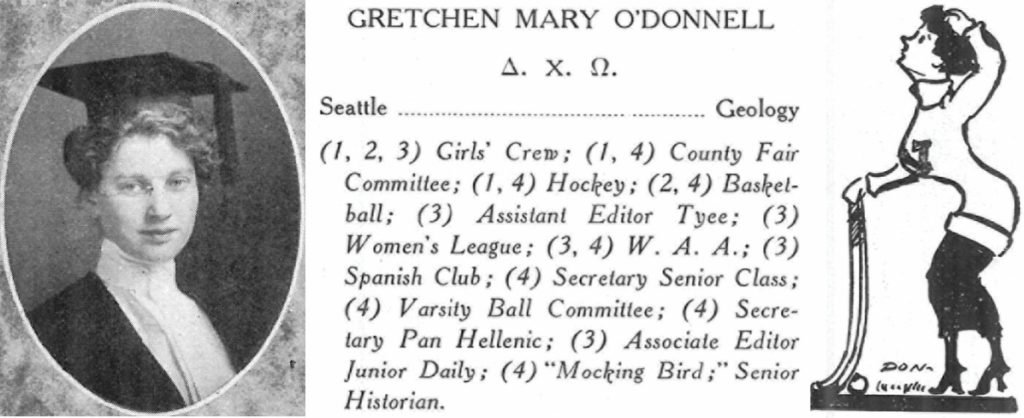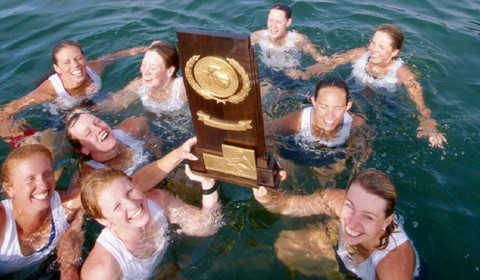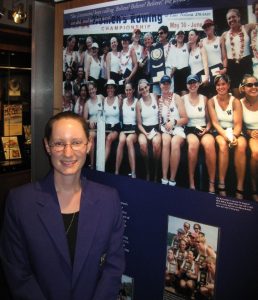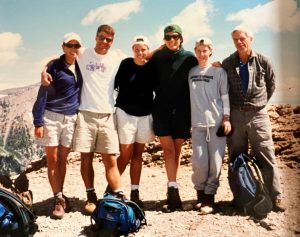While the world celebrates again the “Boys in the Boat,” our department would like to celebrate two geology majors who played historical roles in UW Husky Women’s Crew.
Gretchen O’Donnell and the early history of UW women’s crew and geology

With the move in 1895 of UW’s campus from downtown Seattle to its lake-adjacent modern site, rowing was soon a university activity, with competitions among UW colleges and class competitions on “Junior Day” (later called Class Day). Women were rowing as early as 1903. In 1906, the beginnings of a more formal Women’s rowing program featured a “varsity 4” including two geology/mining students: Fanchon Borie and Mayme Lucas. In 1910, the Class of 1912’s boat won the Junior Day competition, with geology major Gretchen O’Donnell (B.A. 1912) as captain and stroke. Crew Coach Hiram Conibear was supportive of women’s crew and gave them what time he could, but he needed help. In January 1910 O’Donnell, recognized for her leadership and athletic skills, became Conibear’s Assistant Coach focused on the women’s program. Facing significant opposition to the existence of women’s crew on campus, Gretchen helped keep the program alive until she graduated in 1912. Within the decade, women’s crew would cease to exist, despite support from Conibear and efforts, e.g., of Lucy Pocock (champion oarswoman and sister of George Pocock, leading designer and builder of racing shells, who provided them for the 1936 gold-medal-winning UW “Boys in the Boat” crew.)
In this early period, UW was the first co-ed institution to support a women’s crew, but their only possible intercollegiate opponent was on the east coast at Wellesley College; there was no support for such travel. It was decided that if women competed in at least three sports, they could earn a coveted varsity “W”. Thus, Gretchen also played right halfback in (field) hockey and guard in basketball. The cartoon with her yearbook photo shows her in a W sweater holding a hockey stick. Clearly a class leader, she participated in several other leadership roles on campus (see her senior picture). At the same time, she was majoring in Geology, and in her senior year prepared an annotated Bibliography of Washington Geology and Geography, published by the State in 1913.

As with the crew program, the Department of Geology and Mineralogy also had its origins with the move of UW to its modern site. The first professor was Henry Landes (husband of Bertha Knight Landes, later the first woman mayor of a major city – Seattle). Henry taught the entire curriculum. By the time Gretchen O’Donnell attended UW, the department had moved to the new Science Hall (later called Parrington), and there were three geology professors: Landes, Charles Weaver, and Edwin Saunders. Records of undergraduate majors are spotty; preceding Gretchen there are at least three other women majors in geology or its sister department Mining Engineering.
The UW women’s crew revival and 1997 champion coxswain geology major Alida Purves
In the late 1960s, women’s crew at UW was revived as a club sport and had their first intercollegiate competition in 1969. The next year, legendary rower and future UW coach Jan Harville was recruited to row for the women. In this second set of early years, despite the women’s program being clearly subsidiary to the men’s, the women not only persisted, but they also won their first National Women’s Rowing Association championships in 1971 and 1972. Title IX in 1972 helped coach Kit Green claim more resources, and in 1975 women’s rowing once again became a varsity sport.

Fast forward a couple decades to a high school senior in Virginia, captain of her senior-year crew with a passion for rowing, mountains, geology, Russian, and her Christian faith. UW geology major Alida Purves (B.S. 2000) writes, “UW was the only option that fit all my criteria.” Alida contacted head coach Jan Harville and came out for a visit; too small to row collegiately, Purves switched to the position of coxswain. She earned the cox spot on the Freshman 8 crew, then the Junior Varsity Crew, and in her junior year became cox of the Varsity 8. That year—1997 was the first NCAA championship for Women’s Crew. Washington won the day with the Varsity 8 taking 1st place, the Junior Varsity 8 and the Varsity 4 each finishing second place. This secured the first Women’s NCAA championship title for Washington. In 2008, the entire 1997 Women’s Crew Team was inducted into the Husky Sports Hall of Fame; on the 1997 team, another geology major, Tasya Gray (B.S. 1998) rowed the JV 2nd 8+. In 2016, when the Pac-12 named the 1936 UW Men’s Crew of Boy’s in the Boat fame as their Men’s Crew of the Century, the 1997 Varsity 8 boat that Purves coxed was named the Pac-12’s Women’s Crew of the Century.

Also in 1997, double-major Alida won the Merrill Prize for the Geological Sciences outstanding undergraduate major. Alida’s other major was in Russian Language and Literature; when Professor Jody Bourgeois learned of this double skill, she recruited Alida to translate from the Kamchatka tsunami catalogue. Alida recalls that by far her most memorable experiences in the department were her two years in field camp, the first as a student and the second as an undergraduate TA. The first year, she remembers Professor Stu McCallum finding her group unknowingly completely out of the mapping area. Consequently, the next day Stu followed Alida and her mapping partner around, reciting Scottish poetry as he made sure they did not stray too far. The following year, Professor Eric Cheney directed field camp and was also Alida’s department advisor. When he learned that she planned to serve eighteen months as a church missionary (in Russia) before graduating, he advised she finish her degree first, but ended up being very supportive of her decision: “I can’t lie, I was terrified of Eric… [however] that summer at field camp…Eric was amazing…so supportive of me. I feared needlessly. He loved used bookstores and even got me two gifts. I still have them – one was a classic geology textbook he found, and the other – an old James Bond novel – To Russia with Love.”
